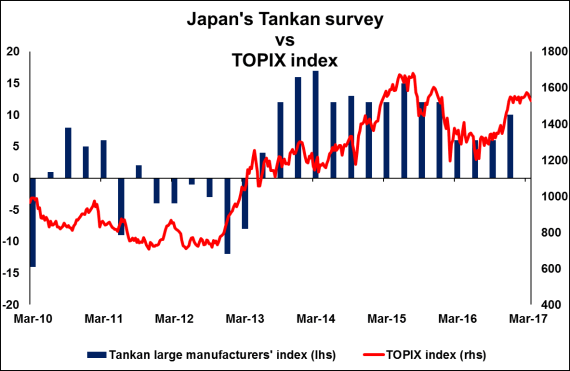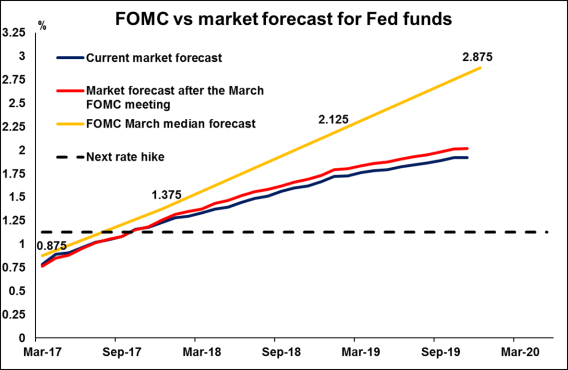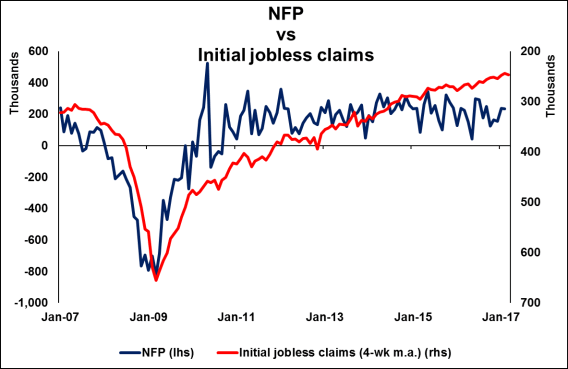Next week’s market movers
- In Australia, we expect the RBA to remain on hold and maintain its neutral bias. However, we see the risks as skewed towards a more dovish narrative.
- In the US, the employment report for March could prove critical to market expectations regarding the timing of the next Fed hike. The minutes from the latest FOMC meeting will also be in focus.
- In Japan, we expect the Tankan survey for Q1 to reveal rising business optimism.
- We also get key economic data from the UK, the US, and Canada.
On Monday, during the Asian morning, the Bank of Japan will release its Tankan business confidence survey for Q1. This is perhaps the most important indicator that comes out from Japan and thus, it will be closely watched. No forecast is available, but bearing in mind that the Reuters Tankan Diffusion Index rose notably in all three months of the quarter, we expect the official indices to move in a similar fashion. This could signal that Japanese firms are feeling more optimistic, something that we believe may be related to the notable depreciation of the yen following the US election late last year. We expect Japanese equity markets to benefit from such a strong report, as it may be a signal that GDP growth is set to pick up steam moving forward. Something like that could also generate some speculation that the BoJ may gradually begin thinking about a slight reduction in its massive stimulus program at its upcoming meetings. However, as long as Japan’s headline and core inflation rates remain stuck near zero, we do not expect anything like that to happen, as the Bank would not want to undermine the effectiveness of its previous easing measures by triggering a tightening in financial conditions.

From the US, we get the ISM manufacturing PMI and thereafter on Wednesday, we get the non-manufacturing index, both for March. Both figures are forecast to decline somewhat, but to still remain well above the key 50 barrier that separates expansion from contraction. Despite the potential declines, given that these indices are expected to remain at very healthy levels, we doubt that they will have a material effect on market pricing regarding the timing of the next FOMC rate hike.

From the UK, we will get the manufacturing PMI for March. Then on Tuesday, we will get the construction index for the month and subsequently on Wednesday, the services figure. No forecast is available for any of these indices. The manufacturing and services indices declined somewhat in February, though they still remained safely above the critical 50 level. The most interesting part of these reports was related to inflation. The service-sector survey, which accounts for the vast majority of the UK economy, showed that prices charged rose at the fastest pace since 2008. It would be interesting to see whether this continued in March, as it could increase speculation for further acceleration in inflation. The latest commentary from BoE policymakers suggests that the Bank is in no hurry to raise rates, despite signs that inflationary pressures are picking up rapidly. As such, we do not expect the BoE to actually hike in coming months, at least not until the Brexit negotiating landscape becomes clearer. We do however believe that further acceleration in inflation could lead to some more hawkish dissents among the Committee, perhaps as early as at the summer meetings.

On Tuesday, during the Asian session, the Reserve Bank of Australia will announce its rate decision. The forecast is for the RBA to remain on hold once again, a view that we share considering the neutral tone the Bank has maintained in all of its recent communications. At the latest meeting, the RBA reiterated that underlying inflation is expected to stay low for some time, while in the minutes of that gathering, we saw that the Bank is also worried that the labor market may not be as strong as the headline employment figures indicate. Even though these signals were relatively dovish, they were balanced by a repetition that high housing prices continue to pose risks to financial stability and that any more rate cuts could amplify such risks further. Since that gathering, the only major piece of economic data we got was the unemployment rate for February, which rose. However, considering that employment indicators tend to be volatile on a monthly basis, we don’t expect a single data point to alter the Bank’s overall bias. Having said that, we think that the risks are tilted towards a more dovish narrative from the RBA. If employment indicators continue to deteriorate, the Bank could lean more towards actually cutting rates, and simultaneously introduce macro-prudential measures in the housing market to limit financial stability risks.

On Wednesday, we get the US ADP employment report for March. The private sector is expected to have added 194k jobs, less than the 298k in February, though still a strong number that is likely to raise speculation for the NFP figure to meet its forecast of 185k. We see the case for the ADP number to be higher than the NFP print as reasonable, considering that Trump’s federal hiring freeze is very possible to have led to diminishing hiring in the public sector.

Later during the day, the Fed will release the minutes of the March FOMC meeting, where the Committee raised interest rates by 25bps, as was very widely expected. However, the signals we received were not as hawkish as one would have expected given how quick this hike was compared to the time elapsed between the first two of this hiking cycle. Firstly, Minneapolis Fed President Neel Kashkari added a dovish touch by dissenting the decision. What’s more, even though the Fed upgraded its forecasts for the US economy, the "dot plot" was left largely unchanged, and Chair Yellen shifted to a much more cautious tone in her press conference compared to her latest appearances. The key message we got was that this hike does not reflect heightened optimism on the economic outlook, and does not imply that future rate hikes will be faster than previously anticipated. It would be interesting to see whether the tone of the minutes is equally cautious, as something like that could push somewhat back market expectations regarding the timing of the next rate hike. However, we believe that Friday’s employment data will probably be a much bigger determinant of when investors will anticipate the Fed’s next move (see below).

We also get the US ISM non-manufacturing PMI for March, as well as the UK services PMI for the same month, as we noted above.
On Thursday, we have a relatively light day, no major events or indicators due to be released.
On Friday, the US employment report for March will take center stage. The forecast is for nonfarm payrolls to have risen by 185k, less than the robust 235k in February, but still a solid number consistent with further tightening in the jobs market. The unemployment rate is forecast to have held steady at 4.7%, while average hourly earnings are expected to have risen at the same pace as previously in monthly terms. This would likely be one more set of data entering the basket of those supporting another near-term Fed rate hike. According to the Fed funds futures, the market is currently pricing in the next hike to come in September. So, a solid employment report could bring those expectations forward, perhaps to anticipate such action in summer months.

We also get employment data for March from Canada.













